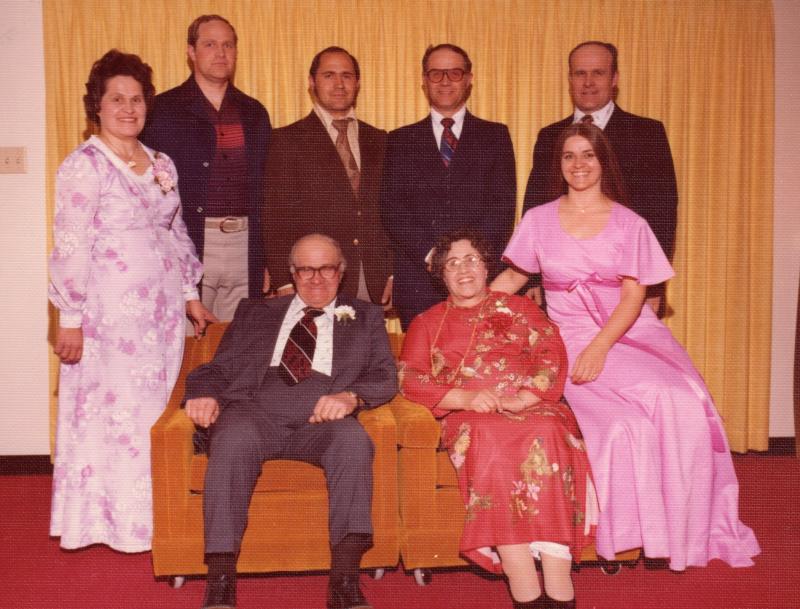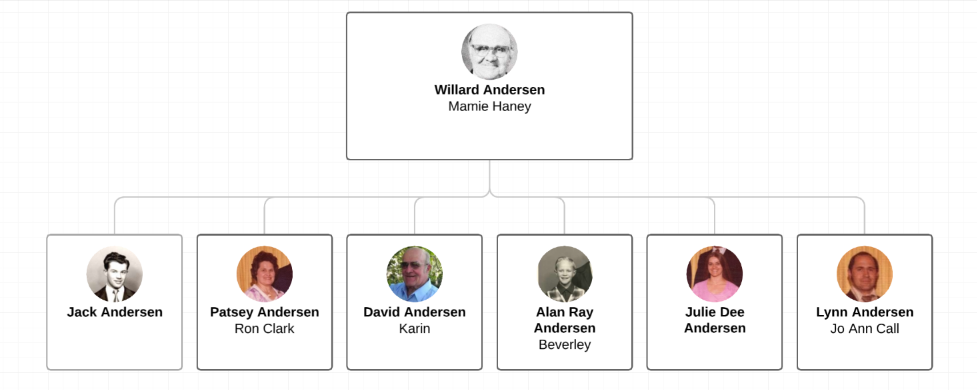Willard & Mamie Andersen


Willard John and Mamie Haney Andersen
Willard was born 16 July 1907 in Mendon, Cache, Utah, the oldest child of John Christian Andersen, one of the original homesteaders in Arbon Valley, and DeSena Sorensen Andersen. Eventually he was joined by his siblings Ada (1909), Andrew Mark (1912), Alane (1915), Hazel (1917), Glenn (1920), and Norman (1924).
Willard had wonderful memories of growing up in Arbon Valley. In the book, Bannock Valley, he claimed that the old timers always called it Bannock Valley, but “to the younger generation it soon became known as Arbon. Some of the original settlers never called it anything but ‘out to Bannock’ †(p. 36).
Arbon Valley was a wonderful place for a boy to grow up. “I spent much of my time riding my old horse in the hills hunting magpies and robbing their nests. I was too young to have a gun so I would catch squirrels with a string. Then I got my first 22. I became a pretty good marksman with that old 22.â€
He started school when he was six, in the one-room school that had about twenty students and one teacher for all eight grades. “I was the only first grader and I liked the teacher real well. There was a pot-bellied stove and the boys had to take turns keeping the wood supply to burn. Two years later the district bought a bigger stove and used coal. The kids were glad because coal lasted longer. Dad took me to school and came for me each evening. During the good weather, Mother took me and came for me in the buggy†(p. 37). This was the old Valley View school that was near where the LDS Church now is.
Doctors were a long way from Arbon Valley in any direction. “As we got older, we had a brown mare that we would ride to school. She was bad to fall down when I went on a lope. Many a spill I took, but I came out the winner with only a few bruises – until one day while I was just sitting in the saddle talking to some other kids, I got over balanced and fell, hitting my arm on a piece of iron. Dad took me to Malad and had my broken arm set.â€
Willard graduated from 8th grade at age thirteen and from then on his life was the farm. “Our farming was done with horses – we kept about twenty head around all the time. I learned…to plow at an early age – starting with four head on a two-bottom plow; then I went to six; then to eight and nine horse on a three-bottom plow. The days were pretty long to stand on the plow and drive all day with about an hour and a half for noon, when we would have to unhook the horses and grain and water them and feed them some hay. Then back to the fields we would go to plow until dark. We ran two outfits – Dad drove one and I the other….It was my job to get up about five every morning and round up the horses for work that day. Sometimes it would be 9 o’clock before I got them all in.â€
Farming has made great advancements. “We cut the hay with a horse-drawn mower….Many changes have taken place since we started haying – stacking it loose – using the old Jackson fork and derrick, with the derrick horse playing an important role along with the derrick boy or girl, whichever was available.”
“Grain harvesting has had a great revolution too. We started out with the header and the thresher. When I was fourteen, I started running the header. We used six horses on this. I wasn’t really big enough to run the header, but I liked it better than running the header box. From there we went to the old horse-drawn combine – this took twelve horses to pull. It took three people to operate this machine – a driver, a bagger, and a sack sewer.”
Willard fulfilled a 28-month LDS mission to the Southern States beginning when he was seventeen years old. In those days the church did not have set ages for missionaries. He departed in January 1925 and came home in May 1927. When he returned, he was put into the Curlew Stake High Council where at age twenty he was the youngest high council member in the whole Church at that time. He later served as First Counselor to Branch President Joe Arbon for ten and a half years, and then as the Arbon branch president for nine and a half years.
He served the Arbon community in many other capacities, too. He was on the school board for many years, and was the Arbon constable for two terms. “We surely had a peaceful and law-abiding community for I never once had to arrest or give a citation to anyone†(p. 38).
Willard married 28 January 1931 in the Salt Lake Temple to Mamie Edrie Haney. She was raised in South Carolina, so this branch of the Andersen family has a lot of southern roots, including Cherokee blood and Confederate Civil War soldiers. Mamie stated, “When we left the valley [to be married], the snow was so deep that cars had to park about ten miles from the home past the Pauline school house were the roads were still passable. Mark [Willard’s brother] took us down to the car in the sleigh. Then we transferred to the car and went to Pocatello where we boarded the train for Salt Lake City” (p. 39).
Willard and Mamie were the parents of six children: Elmo Jack, Patsy Grace, David Revell, Allen Ray, Julia Dee, and Willard Lynn. Willard Lynn, their youngest, took over the farm and raised his family in Arbon Valley.
Willard and Mamie finally moved to Pocatello so their children could attend high school. He still farmed and went back and forth between Pocatello and Arbon during the school year.
Willard died 1 August 1996 in Pocatello, Idaho, and was buried in his beloved Arbon Valley, in the cemetery within sight of the land his father had homesteaded over a hundred years before. Mamie joined him in the Arbon Cemetery in October 2005.
Sources:
Call, Laurie Jean, Bannock Valley (Providence, Utah: Keith Watkins and Sons, 1989). Most of the quotes are from Willard’s own memoir contained in this source.
